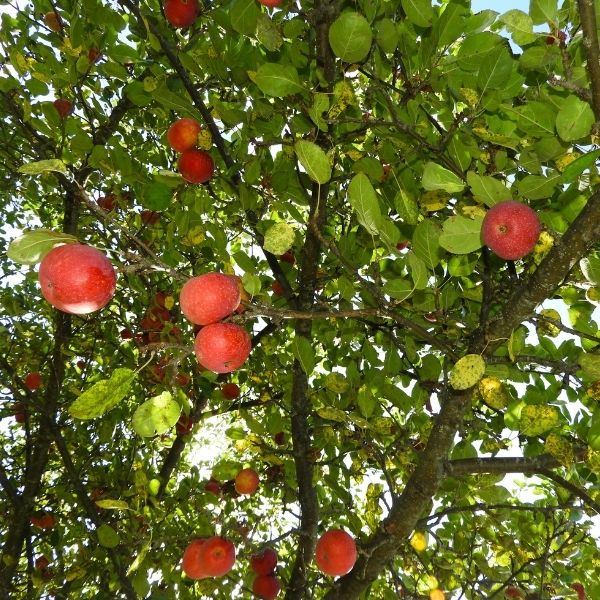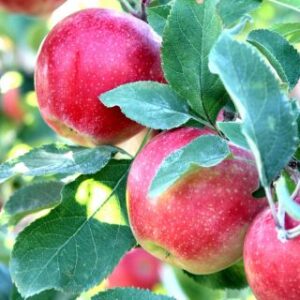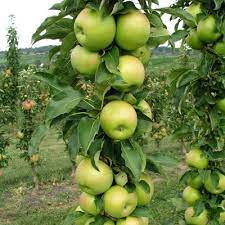Hail to the King! The King Apple Tree (Malus ‘King’) that is! This cold-hardy fruit tree stays smaller for easy placement anywhere in a sunny landscape and does not overtake your entire yard! Small fruit trees make it easy for anyone anywhere to enjoy fresh fruit access in their own backyard! And these trees are ornamental enough to include in your front yard landscaping too!
Spring brings all the pollinators to your yard when the white blossoms burst and carry with them a sweet fragrance! The glossy foliage adds to the uniform canopy of these tidy trees and acts as a fantastic accent tree.
King Apples are large red-skinned fruits with yellowish-green stripes. They are highly valued for their cooking and juicing qualities, but are also great for fresh eating and canning! Storing well and ripening late, be sure to plant with other earlier ripening apples for an extended and varied harvest!
Planting and Application:
The lovely blossoms, fall color and general shape of these smaller trees contribute to their use as edible landscaping trees for about any location in your sunny landscape! Keep pruned smaller yet for easy harvest and better placement.
King Apples are not self-fruitful so you’ll need one or more compatible trees nearby to pollinate them. Group these trees in clusters or in orchards, or try linear orchards when space is tight and create hedgerows of apple trees for a bird-friendly, living fence the neighbors won’t mind either! Mix several types of Apple Trees together for maximum pollination and to extend your harvest all growing season long!
- Red Apples Striped Yellow & Green
- Sweet-Tart Firm Fruit
- Fragrant White Blossoms
- Late Season Harvest
- Smaller Sized Tree
#ProPlantTips for Care:
Apple Trees love basking in the full sun, so provide a sunny location with great air circulation and well-drained soil. Enrich the site with plenty of organic matter and top off with a good layer of mulch.
- Full Sun
- Well-Drained Enriched Soil
- Moderate Yet Consistent Moisture
- Prune When Dormant
- 800-1000 Chill Hours
A King Apple Tree is sure to crown your orchard this year with a large harvest of delicious fruit and secure your food accessibility beautifully! Order today at NatureHills.com!
King Apple Tree Frequently Asked Questions
When to Plant King Apple Trees
Planting Bareroot trees as soon as you can dig a hole in spring and until hot weather, the earlier the better. Plant container Apple trees throughout the growing season with complete success – that is the benefit of container plants – to extend the planting season. Your County Agricultural Extension Office is a great resource for first and last frost dates in your area.
How to Plant King Apple Trees
Dig a large hole only as deep as needed to accommodate the bareroot or container root ball, and twice as wide. Add Nature Hills Root Booster to speed root establishment. Remove the pot or bag and situate it into the hole so the top of the soil (soil line if bareroot), is level with the new location’s soil being careful not to plant too deep. Water in again very well and backfill with the same soil you dug up, tamping down gently to ensure there are no air pockets.
Top off with a 3-4 inch thick layer of Arborist mulch. Consider staking your tree to keep its trunk growing straight for the first year to ensure it stands tall against strong winds and drifting snow.
When to Prune King Apple Trees
Trim off any broken branches from delivery as soon as you take them out of the box. Prune and trim apple trees while dormant, in late winter or early spring, before you see new growth.
How to Prune King Apple Trees
Dormant prune to:
- Remove any double leaders or narrow crotch angles
- Eliminate any crossing branches
- Thin interior branching and leave the fruiting spurs and strong branches in place opening up the canopy
- Branching at least 24-36 inches above the ground
Prune Apple trees in the summer to:
- Control size and shape by reducing the length of longer new growth on vigorous trees
- Remove water sprouts on the main trunk or older branches in the crown
- Remove suckers at the base of the trunk
- Thin fruit during heavy years on established trees
How to Care for King Apple Trees
Growing an apple tree is easy when proper soil, good drainage, attention to moisture, and regular fertility are maintained. Once you’ve chosen an apple tree that works for your climate, in the size you need for your landscape, and its pollinator (if needed), then you’ve accomplished half the battle!
- Apple trees do best in full sun and well-drained soil
- Water your apple trees when it gets dry – especially during the fruit production stage, and drought periods to keep it stress-free
- Use arborists’ wood chips to mulch over the roots of your apples and have your soil tested to see what your soil may be lacking before adding fertilizers
- Maintenance pruning and shaping
Apple trees will tolerate a wide range of soils, so long as water and nutrients are not limited and the pH level is adequate.
How to Fertilize King Apple Trees
For the first year, water alone is most important. It is always best to get a soil test to see what your soil is lacking before adding more fertilizers. Once established, a fertilizer routine may be beneficial. We do offer some excellent slow-release organic options, applied according to the package directions.
Fruit trees need more phosphate and it’s possible to apply too much nitrogen which affects the soil’s pH. Test soil acidity or alkalinity using a pH Tester.
Fertilize in spring when you first see new growth emerging.
- Don’t overdo it
- Phosphates are your friends
- Pay attention to pH in areas with extremely high or low soil pH
- Follow the directions
King Apple Tree Pollinating Info
King is not self-fruiting and needs a pollinating partner. Pair with one of these varieties:
- Cortland Apple Tree
- Dolgo Crabapple Tree
- Fuji Apple Tree
- Gala Apple Tree
- Chestnut Crabapple Tree
- Golden Delicious Apple Tree
- Granny Smith Apple Tree
- Red Jonathan Apple Tree
- McIntosh Apple Tree
Harvest Times for King Apple Trees
King’s are typically ready to harvest in October.
Early-Season? Mid-Season? Late-Season? The terminology can be confusing for new apple tree growers. Weather, climate and your tree determine when it’s ripe.
For Apples:
- Early-season is usually June-July
- Mid-season can be August-September
- Late-season can be from late September-November
The growing season consists of spring, summer, and fall, and varies with climate and weather. Areas with longer growing seasons in the warmer hardiness zones can greatly affect the harvest times for each particular apple variety grown in your area. Learn which growing zone you are in.
What Shipping Options Do You Offer?
NatureHills.com works closely with our growers and nursery professionals to ensure we ship when it is most appropriate for your area. Our goal is to deliver the hardiest plants by avoiding extreme high and low temperatures. Check out our shipping schedule for more information and to learn our wills and won’ts when it comes to shipping plants. Find your King Apple Tree for sale here at NatureHills.com!




Reviews
There are no reviews yet.